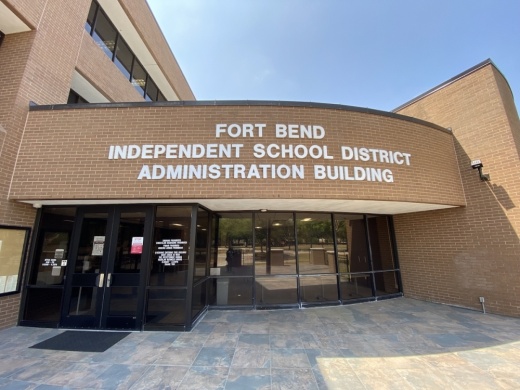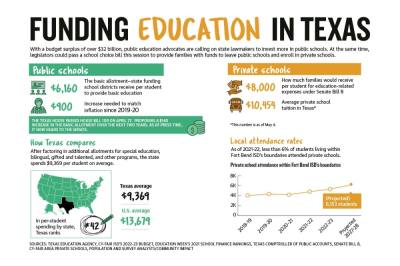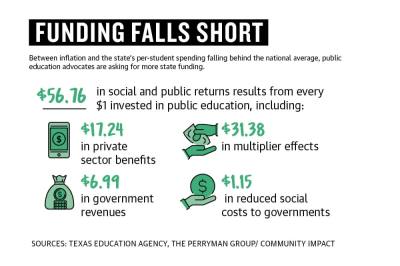Senate Bill 8, filed by Sen. Brandon Creighton, R-Conroe, would create an education savings account program, also known as private school vouchers. Parents who pull their children out of public schools could receive $8,000 per student for private school tuition and other education-related expenses.
SB 8 is one of Gov. Greg Abbott’s seven emergency priorities for the 88th legislative session.
“My job is to make sure we get across the finish line a piece of legislation that will return mom and dad to being in charge of their child’s education,” he said during a visit to Cypress Christian School on March 21.
The Legislative Budget Board reported the program would cost the state over $531 million through August 2025. While the program would not use funds allocated for public schools, opponents of the legislation have expressed concerns that more funding is needed in public schools, which could lose more money if their students leave to attend private schools.
The basic allotment—the amount school districts receive from the state per student to provide a basic level of education—has been set at $6,160 per student since the 2019-20 school year. Texas ranks No. 42 nationally in per-student spending, according to Education Week’s 2021 School Finance Rankings.
The Texas comptroller of public accounts reported a $900 increase would be needed just to keep up with inflation; however, based on the legislation moving through the Texas House as of press time, legislators were looking at a $140 increase. In 2019, House Bill 3 included a $1,020 increase, the last adjustment to the basic per-student allotment.
“We are begging for any morsel of additional funding for public schools, and where vouchers come in is they do the opposite,” said Laura Yeager, director of Just Fund It TX, at an April 4 press conference.
Some school districts across the state, including Fort Bend ISD, approved budget deficits in fiscal year 2022-23 due to limited funding. Community Impact previously reported FBISD’s $768 million budget included a $19.8 million deficit with state funding making up 37% of revenue and local property taxes making up 59%.
Public education advocates have also raised concerns private schools are not required to meet state and federal standards for accountability, accessibility and safety.
“Under this measure, public taxpayer dollars would go to private entities instead of to public education, and is it going there with no accountability?” FBISD Superintendent Christie Whitbeck said in an emailed statement. “Public schools are accountable for every aspect of their operations—academic, financial, safety, teacher certifications and so on. This proposed legislation would create an uneven playing field.”
A closer look at SB 8
If this bill becomes law, students enrolled in public schools and students enrolling in public kindergarten or pre-K for the first time could apply for an education savings account. Some low-income students already enrolled in private schools may also be eligible, Creighton said.
Amendments proposed to require private schools receiving voucher funds to meet the same accountability or safety training standards as Texas public schools were voted down by the Senate. Ultimately, the bill passed out of the Senate with an 18-13 vote April 6—one Republican and all Democrats voted against it.
As of press time, the bill was referred to the House. The same day SB 8 passed in the Senate, the House amended the state budget to prohibit the use of public funds for education savings accounts in an 86-52 vote. A similar amendment passed with 115 votes during the 2021 legislative session, showing an increase in support for the programs since then, but strong opposition remains.
During previous legislative sessions, voucher programs have died in the House without a committee hearing.
Michael Barba, K-12 education policy director at the Texas Public Policy Foundation, a conservative think tank based in Austin, said he believes SB 8 would make “great progress” toward giving parents alternatives if they have concerns about the quality of their children’s education.
Data provided by the TPPF shows about 1.6 million students across the state, or 55.3%, are below grade level in English language arts and reading classes, and about 1.5 million are below grade level in math, or 62.5%.
“The reason [parents] are voicing their concerns now is because they see that the education that was provided throughout the time of COVID[-19] either isn’t up to the level of quality that they expect for their child, or it’s not aligned with their family values,” Barba said.
Although public schools are required to teach to standards established by the State Board of Education, private schools do not have the same restrictions regarding what they can teach students.
Public school impacts
Statewide public education advocacy nonprofit Raise Your Hand Texas was founded 17 years ago primarily to push back against the voucher movement happening in the Texas Legislature at the time, Senior Director of Policy Bob Popinski said.
Since then, there have been a few attempts to bring education savings accounts to Texas, but Popinski said he believes the concept is getting more momentum this session because this has become a growing national trend since the pandemic.
Popinski said there are no benefits to public schools under such programs.
“You are taking money and diverting it from public schools to a private school or vendor that does not have to offer the same accountability as a public school,” he said.
Public schools are held accountable through many avenues, Popinski said, including being governed by locally elected school boards and following publicly reported, state-mandated measures, such as standardized testing, the A-F accountability rating system, a financial integrity rating system and certification provisions. Private schools receiving voucher funds would not be subject to these standards, he said.
This program would also negatively affect public schools financially, as the state funding they received is based on students’ average daily attendance. If five or six students opt to take the voucher and leave their public school, that funding loss equates to a teacher’s salary, Popinski said.
Barba argues that data from comparable programs across the country shows a minimal impact on public school attendance. He said similar programs nationally show less than 3% of eligible students use the program in the first five years after its inception, which would amount to about 60,000 students transferring in Texas.
“So the idea that there’s an exodus is a myth,” Barba said.
Barba said he believes school choice programs can lead to improved public school systems, and families choosing alternative options acts as a signal to districts to design their programs to better suit families’ needs.
“When you give families choices, the school districts also improve, and that improves education for every child in the community,” he said.
Popinski said vouchers in Texas would cost about $1 billion a year, and he would rather see those funds used to increase the basic allotment.
“Instead of spending dollars on a new voucher program for private schools and vendors ... why not use that general revenue to actually bolster public education and get them more resources for teacher pay raises, for new programs, for expanding the things that work?” Popinski said.
Renee Farmer contributed to this report.










